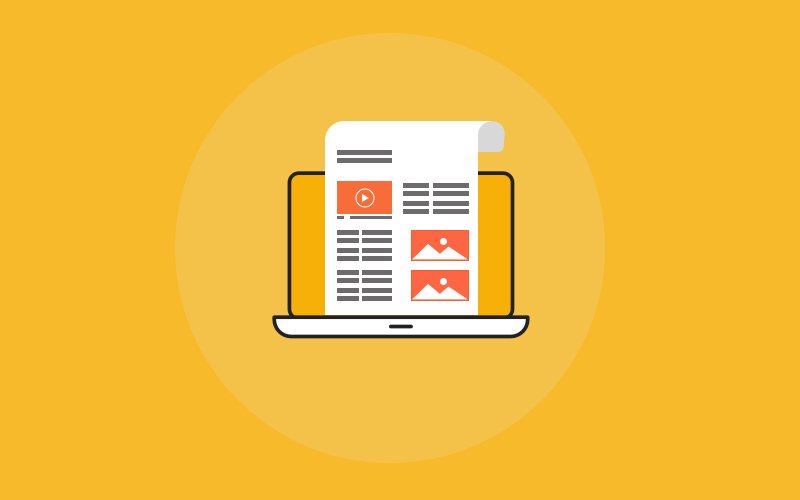Every manager faces the challenge of addressing team members whose performance doesn’t quite hit the mark. As an expert in the training industry, I understand the delicate balance of nurturing talent while ensuring company goals are met. Incorporating strategic training into a performance improvement plan (PIP) is key.
Today, I’m here to guide you through creating effective PIPs that encourage growth through targeted training interventions for achieving individual and organizational objectives.
What Is a Performance Improvement Plan (PIP)?
A performance improvement plan (PIP) is a formal document managers use to address and improve an employee’s performance that is not meeting expected standards.
The plan typically outlines specific areas where performance is lacking, sets clear, achievable goals for improvement, includes a timeline for achieving these goals, and details the support and resources available to the employee to help them succeed.
Benefits of Performance Improvement Plan for Employees and Employers
A performance improvement plan might sound like a corporate boogeyman, but it’s a secret weapon for employees and employers. Let’s unpack the goodies hidden in a well-structured PIP.
- Clarification of Expectations: A PIP clearly outlines what the company expects from its employees. It’s like handing out a roadmap that says, “This is the way to success.” This ensures everyone is on the same page and working towards the same goals.
- Opportunity for Improvement: A PIP offers a chance to correct course before serious actions like termination are considered. It’s a friendly reminder that says, “Let’s adjust a few things and keep moving forward.” This helps employees improve with the support of their management.
- Identifying Underlying Issues: A PIP can reveal the real reasons behind performance issues, whether related to skills that need sharpening or other work-related challenges. It’s about uncovering the facts and addressing them, not just guessing. Here’s a short course on how to turn your employees into high performers:

- Legal Protection: Having a documented PIP provides a record that you’ve given employees a fair chance to improve. This can be essential if legal questions arise, showing that you’ve followed a thoughtful and supportive process.
- Employee Development: A PIP isn’t just about pointing out problems but is a tool for growth. It typically includes access to training and resources needed to enhance skills and performance. It’s a way to invest in your team’s development and commit to their success.
With this approach, a PIP becomes more than just a procedure; it’s a constructive step toward building a stronger, more capable team. Ready to guide your team to better performance? Let’s make it happen!
Wondering how? Will discuss this. But before that, let’s quickly go through the components.
Key Components of a Performance Improvement Plan
As a training professional, I am involved in the development and execution of PIPs. These plans are vital for aligning employee performance with the overall goals of our organization. Here are the essential components I focus on when contributing to a PIP:
- Objective and Specific Issues: It is essential to start with a clear statement of the performance issues. The employee must understand exactly where and how their performance falls short, which sets the foundation for the entire plan.
- Expected Performance Standards: I always clarify what successful performance looks like, detailing the standards and objectives that must be met. This ensures that the employee has a clear target to aim for.
- Action Plan for Improvement: Providing a detailed action plan is critical. This includes outlining the specific behaviors, actions, or skills that need improvement and suggesting how these improvements can be made.
- Support and Resources: Offering support is a key part of the process. Whether training, access to a mentor, or regular feedback sessions, it’s important to give the employees the tools they need to succeed.
- Timeline for Achievement: Setting a clear timeline helps manage expectations and keeps the improvement process on track. It includes deadlines for milestones and the overall duration of the PIP.
- Method of Evaluation: It is vital to explain how improvement will be measured and monitored. I use specific metrics or criteria to assess progress, ensuring that both the employee and I know what success looks like. Read this post to know more.
- Consequences of Non-Improvement: If performance does not improve within the set timeline, it’s also necessary to outline the potential outcomes. These might include changes in position, reduced responsibilities, or even termination.
How to Create a Performance Improvement Plan
I have seen many people struggle with creating effective performance improvement plans, and you may have read many blogs and articles on how to do so.
But today, I’ll take a different approach because I will show you how to create a PIP and overcome the challenges you might face. Here’s how I approach it based on my experiences:
1. Identify the Problem
Problem: Vague problem definitions can lead to confusion and resistance from the employee. The employee might not know how to proceed without clearly understanding what needs improvement.
Solution: Clearly define the performance issues. This should be one of the most important parts of performance improvement plans. Use specific examples to illustrate the problem. I always believe in providing constructive feedback. Highlight areas that need improvement, such as “You missed sales targets by 20% for the last three quarters,” instead of general comments like “Your performance is poor.” This helps the employee understand exactly where they need to focus.
2. Set Clear Objectives
Problem: Vague goals can fail. If goals are not specific, measurable, achievable, relevant, and time-bound (SMART), tracking progress and measuring success is hard.
Solution: Outline SMART goals. For example, instead of “improve sales,” set a goal like “achieve a sales target of $50,000 per quarter within the next six months.” This provides a clear target and timeline.
3. Develop an Action Plan
Problem: General action plans don’t provide clear guidance. Employees might not know what steps to take or how to prioritize tasks.
Solution: Create a detailed action plan. Include specific actions such as attending a sales training workshop by a certain date, scheduling weekly coaching sessions, and using CRM software to track customer follow-ups.
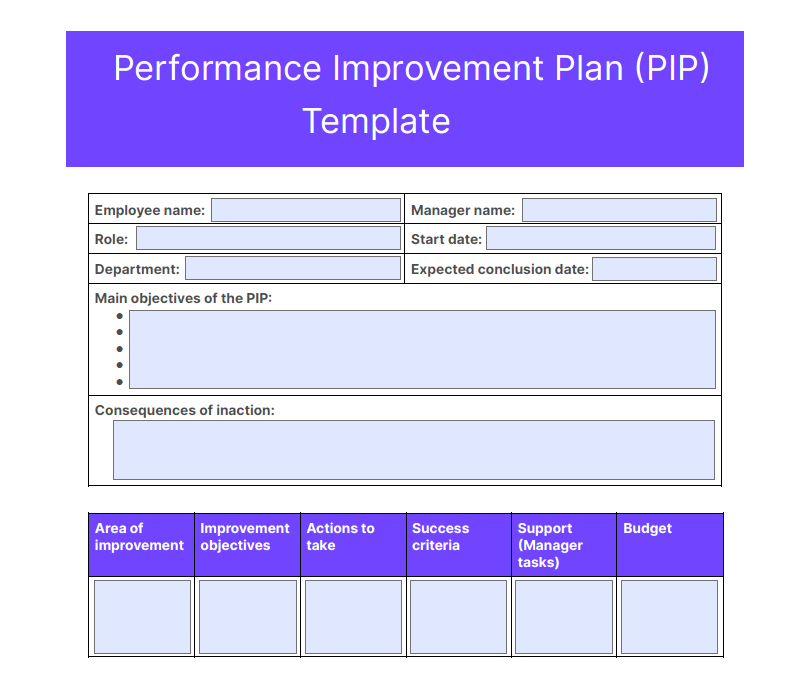
4. Provide Support and Resources
Problem: Lack of support and resources can hinder improvement. Employees can’t develop the necessary skills without access to the necessary tools and training.
Solution: Offer the necessary support and resources. Provide access to training materials, time to attend workshops, and one-on-one coaching sessions. Ensure the employee knows how to use these resources effectively.
5. Set a Timeline
Problem: Without a timeline, it’s difficult to track progress and ensure timely improvements. Without clear deadlines, employees might procrastinate or lose focus.
Solution: Establish a clear timeline for the PIP. Specify deadlines for each objective and action item. This will help you track progress and maintain focus.
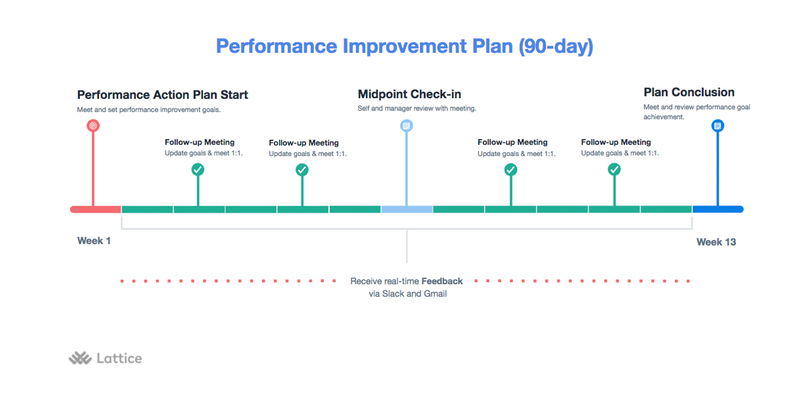
6. Monitor Progress
Problem: Infrequent monitoring can lead to issues going unnoticed until too late. You might miss opportunities to provide feedback and make adjustments without regular check-ins.
Solution: Regularly check in with the employee to monitor progress. For example, if you’ve assigned your employees to complete specific training and assessments, regular check-ins can help ensure they are on track and promptly address any challenges. Schedule frequent reviews to provide feedback and adjust the plan if necessary.
7. Evaluate the Outcome
Problem: If the final evaluation is too subjective, it can lead to disagreements and dissatisfaction. It’s important to have clear criteria for success.
Solution: At the end of the timeline, evaluate the employee’s performance against the set objectives. Determine if the goals have been met and if there has been an improvement. Use the initial problem definition and goals as benchmarks.

8. Document Everything
Problem: Lack of documentation can lead to misunderstandings and disputes. Without records, progress and accountability are difficult to track.
Solution: Keep detailed records of all communications, meetings, and progress. Documentation is crucial for future reference and ensures transparency. I prefer using online documentation software for this purpose.
Here’s a sample PIP plan for you:
Employee Name: John Doe
Department: Sales
Date: July 4, 2024
Performance Issues:
- Missing sales targets for the last three quarters
- Inadequate customer follow-up
Objectives:
- Achieve a sales target of $50,000 per quarter within six months.
- Improve customer follow-up process by making follow-up calls within 24 hours of a client meeting.
Action Plan:
- Attend a sales training workshop by July 15, 2024.
- Schedule weekly coaching sessions with the sales manager.
- Use CRM software to track and manage customer follow-ups.
Timeline:
- Sales training: July 15, 2024
- Weekly coaching: Every Monday
- Review progress: Monthly check-ins
Support and Resources:
- Access to online sales training modules
- CRM software training
Review Dates:
- August 4, 2024
- September 4, 2024
- October 4, 2024
Outcome Evaluation: Evaluate if John has met his sales target and improved customer follow-up by the end of the six-month period.
Get Free Employee Training Software — All Features, Forever.
We've helped 567 companies train 200,000+ employees. Create courses in under a minute with our AI LMS or use 200+ ready-made courses on compliance, harassment, DEI, onboarding, and more!
4 PIP Templates and Examples
We’ve all been stuck in boring performance review cycles. But what if you could make them engaging, effective, and truly beneficial for you and your team?
Here’s your key to unlocking better reviews: These fantastic PIP examples will revolutionize your performance review process.
Template 1: Employee Performance Survey Template by ProProfs Survey Maker
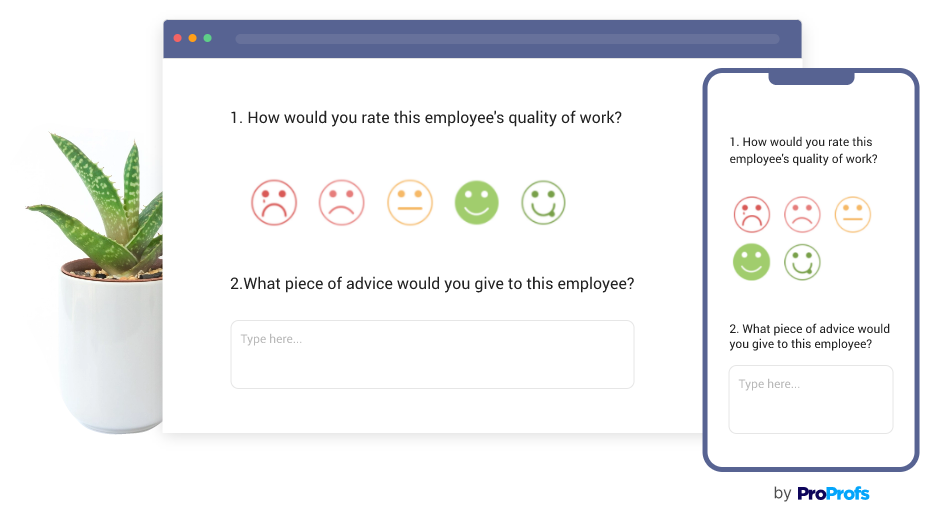
The ProProfs employee performance survey template is designed to assess different areas of employee performance, such as the quality of work, adherence to deadlines, strengths, weaknesses, and so on. This PIP template allows you to customize the survey based on your specific needs with over 20 question types and a library of 100,000 ready-to-use professional questions.
Template 2: Performance Improvement Plan Template by Asana
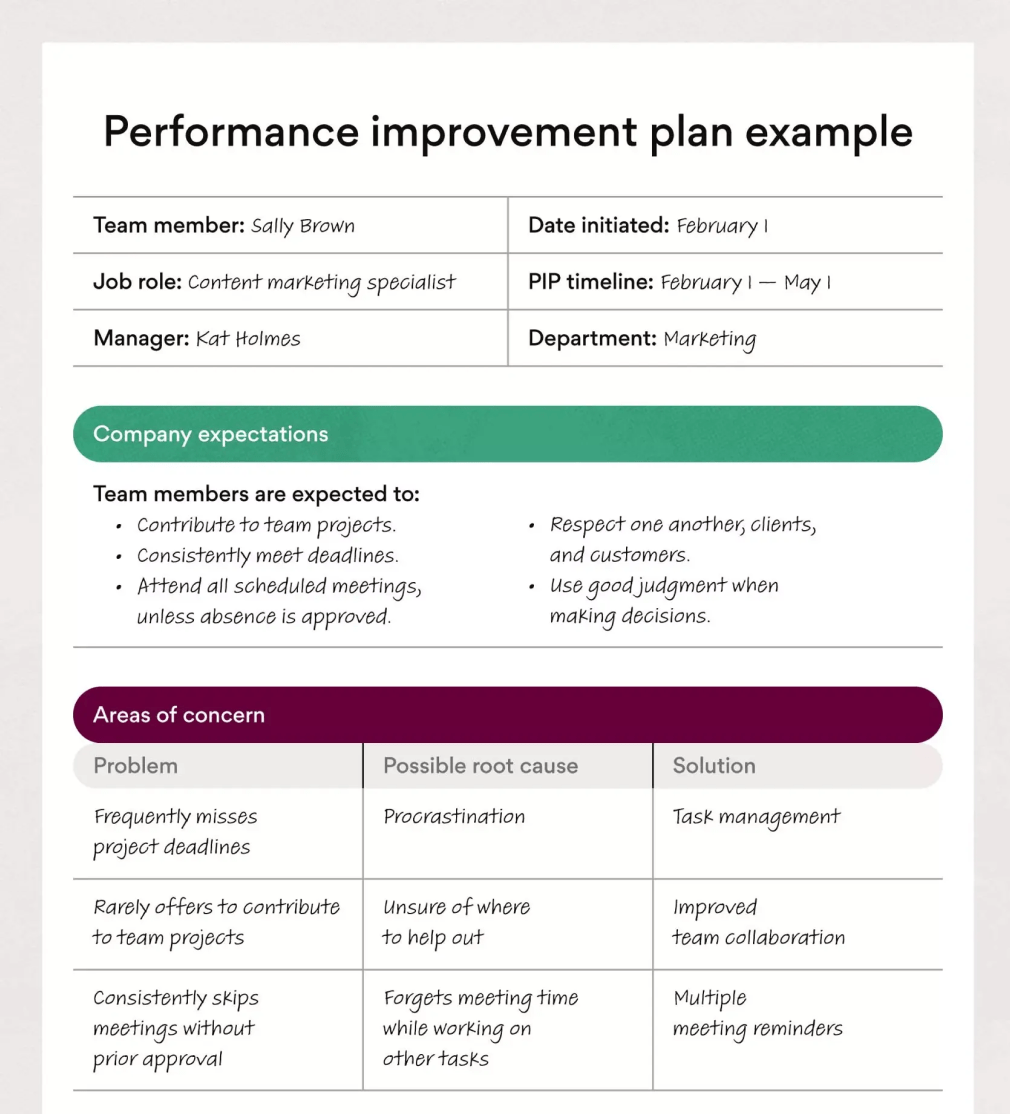
Asana’s sample PIP template is your guide to success in performance improvement. It clearly outlines expectations, identifies areas needing work, and sets SMART goals. Employees and managers can stay focused on achieving results with a clear plan and regular check-ins.
Template 3: Employee Development Plan Template by ClickUp
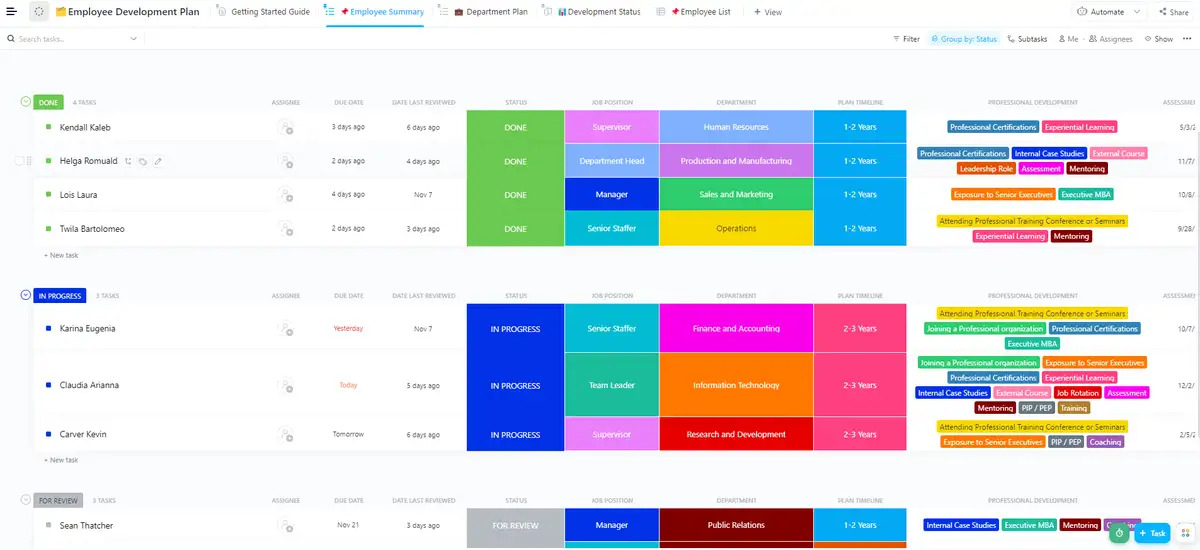
This template is all about empowering your team to reach their full potential. It helps you create personalized plans to develop and enhance new skills. By tracking progress and celebrating achievements, you’ll foster a growth mindset within your organization.
Template 4: Performance Improvement Plan Template by AIHR
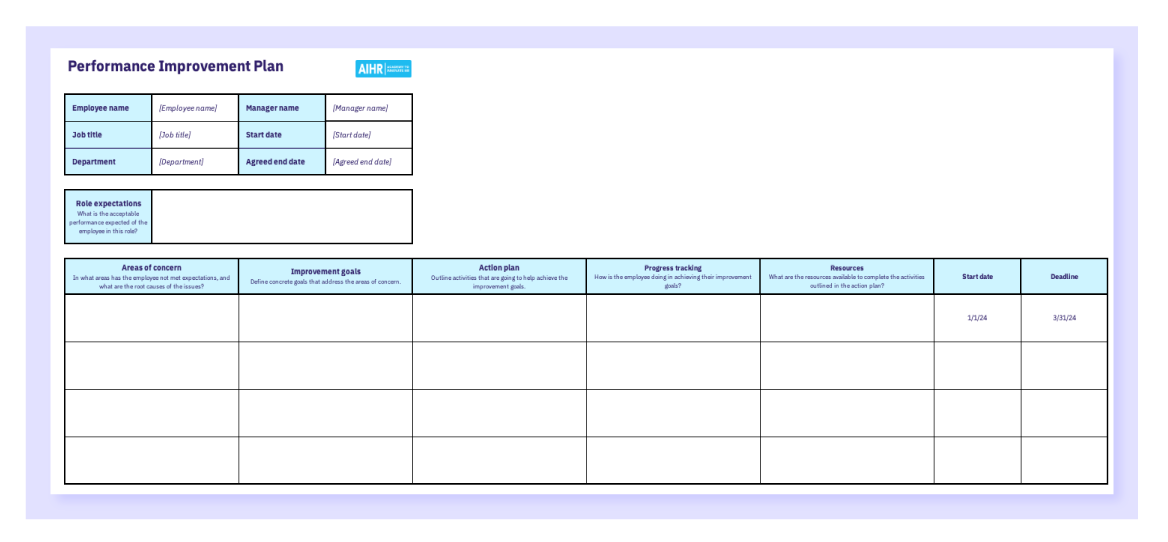
This template provides a structured approach to addressing performance concerns. It includes clear goals, actionable steps, support resources, and review schedules. It ensures everyone is on the same page and working towards positive outcomes.
Ready to transform your employee improvement plan? Grab these templates and watch your team soar!
How to Implement a Performance Improvement Plan
A well-structured PIP can be a valuable tool for addressing employee performance concerns. Here’s a step-by-step guide to its effective implementation:
1. Collaborative Development
- Pre-Meeting: Before initiating the PIP, schedule a meeting with the employee and HR (if applicable) to discuss performance issues.
- Shared Ownership: During the meeting, clearly outline the areas needing improvement and ensure the employee understands the concerns. Encourage open communication to address any questions or clarifications.
2. Crafting the Performance Improvement Plan
- SMART Goals: Develop clear, measurable, achievable, relevant, and time-bound (SMART) objectives for the employee to address the performance gaps.
- Actionable Steps: Break down the objectives into specific, actionable steps. This provides a roadmap for improvement and helps the employee track their progress.
3. Ongoing Support
- Regular Check-ins: Schedule meetings with the employee to provide feedback, answer questions, and offer support.
- Progress Monitoring: Track the employee’s progress towards achieving the outlined goals. This allows for adjustments to the plan if necessary.
4. Evaluation and Outcomes
- Formal Review: Upon completing the PIP, conduct a formal review to assess the employee’s progress against the established goals.
- Clear Communication: Communicate the outcome of the review to the employee transparently and professionally.
Remember, the goal is to guide the employee toward success and ensure their continued contribution to the team’s overall performance.
Are You Ready to Create the Best Performance Improvement Plans?
Performance Improvement Plans can feel like a roadblock. But with clear communication and a collaborative approach, they can become a powerful springboard for employee growth.
Focus on the “How,” Not the “Why.” Craft a PIP outlining achievable goals and practical improvement steps instead of dwelling on past missteps.
Make It a Two-Way Street. Open communication is key. Encourage questions and feedback from the employee throughout the PIP process.
Remember, a well-thought out PIP is an opportunity to invest in your employees’ potential. By fostering a supportive environment and focusing on progress, you can turn a potential setback into a change for future success.
 Tips
Tips
We’d love to hear your tips & suggestions on this article!
Get Free Employee Training Software — All Features, Forever.
We've helped 567 companies train 200,000+ employees. Create courses in under a minute with our AI LMS or use 200+ ready-made courses on compliance, harassment, DEI, onboarding, and more!

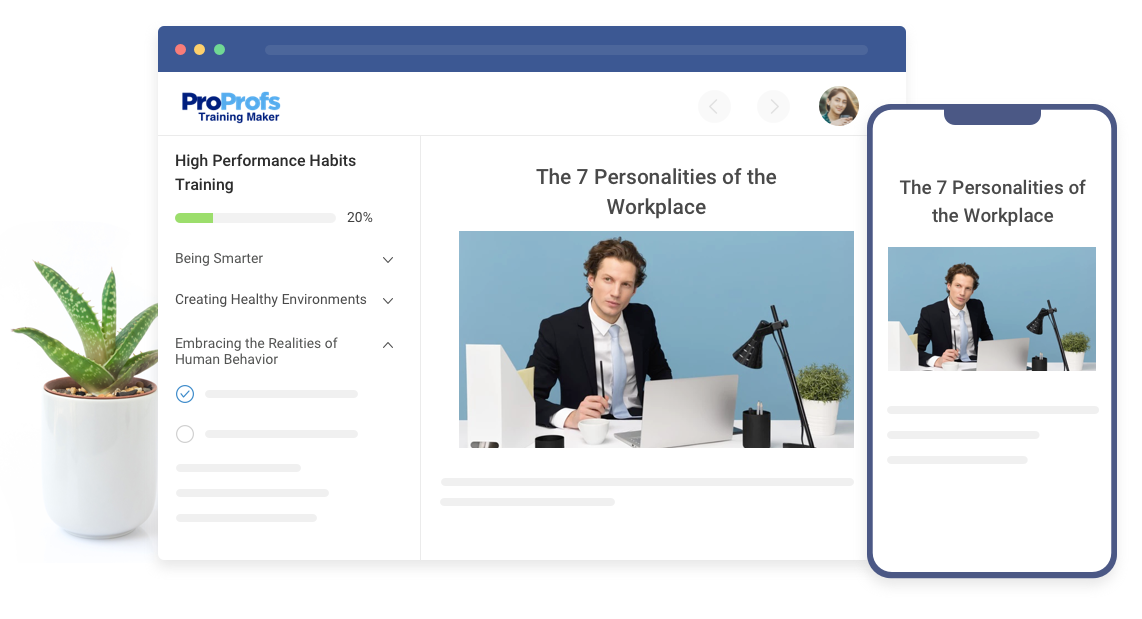
 We'd love your feedback!
We'd love your feedback! Thanks for your feedback!
Thanks for your feedback!






